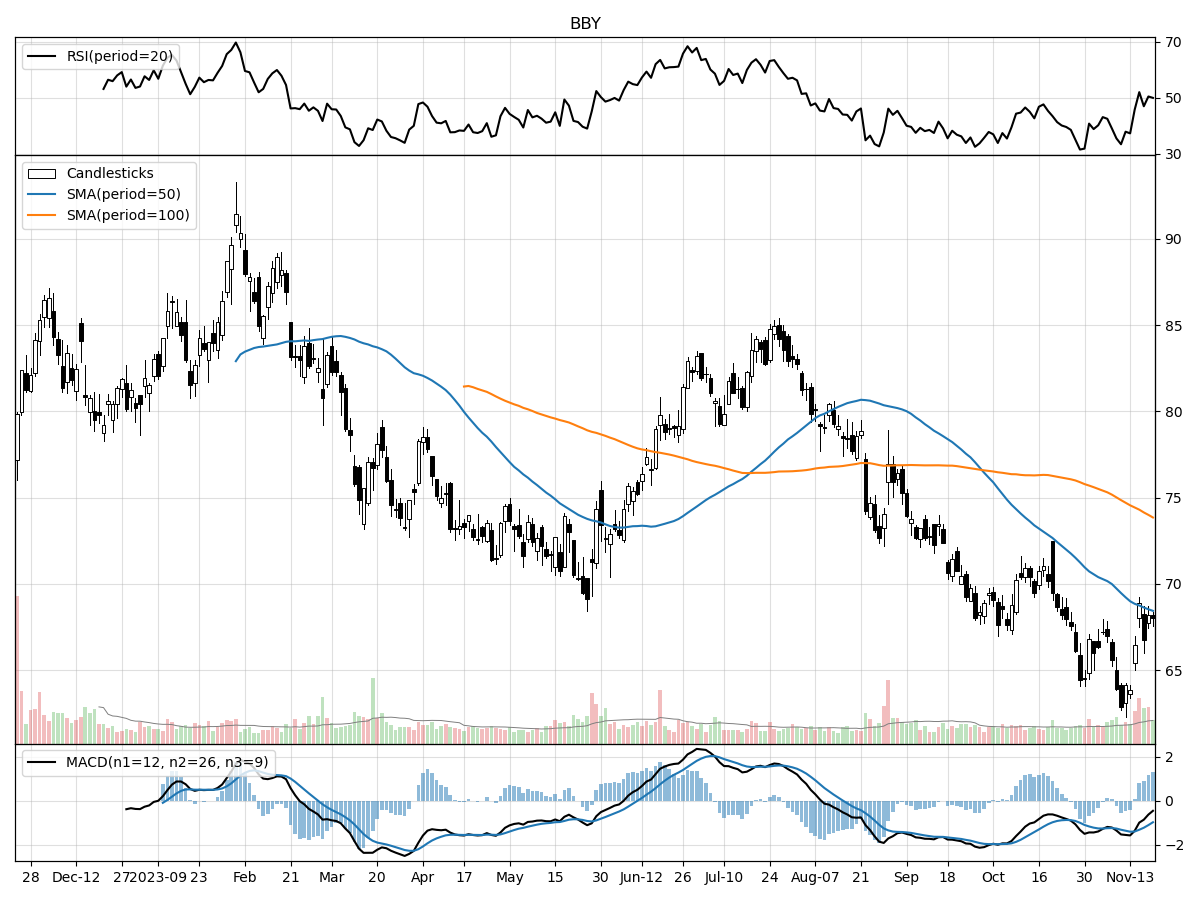Is Best Buy a Buy?
While Best Buy has been a leading retailer in the electronics space, the combination of declining financial metrics, challenging economic conditions, fierce competition, operational vulnerabilities, and regulatory risks paint a picture that should give investors pause

BEST BUY CO INC (BBY),
November 20, 2023
(AI generated investment deep dive into a company of interest)
Company Overview
Best Buy Co., Inc., established in Minnesota in 1966, operates in two primary segments: Domestic and International, predominantly in the US and Canada. They offer an omnichannel platform that provides computer-related products, consumer electronics, appliances, entertainment, services, and other consumer goods. Best Buy's business model relies on a diverse supply base, with the majority of their merchandise sourced from their top 20 suppliers. The company operates 1,138 stores and views them as a crucial component of their omnichannel strategy. Most of their revenue and earnings are generated in the fourth quarter, during the holiday shopping season.
Best Buy is a leading technology company with a focus on retail, online platforms, and in-home services. They have over 90,000 employees and strong partnerships with top tech vendors. Best Buy is also committed to reducing their carbon footprint and has invested significantly in solar fields. They adhere to the United Nations Guiding Principles on Business and Human Rights and are active participants in the Responsible Business Alliance. In addition to selling top-tier technology products, Best Buy also focuses on repairing and recycling consumer electronics, promoting energy-efficient products, and supporting community programs that promote tech education and inclusivity. They also provide financial aid to employees in hardship, raise awareness about mental health, and offer tuition assistance to employees. The company complies with Exchange Act reporting requirements and makes related documents and reports available on its website after filing with the U.S. Securities and Exchange Commission.
By the Numbers
Annual 10-K Report Summary (Fiscal 2023):
- Total revenue: $46.3 billion (down 10.6% from the previous year)
- Comparable sales: decreased by 9.9%
- Digital sales: 33% of Domestic revenue (up from 19% in fiscal 2020)
- Gross profit: $9.9 billion
- Net earnings: $1.4 billion (down from $2.4 billion in the previous year)
- Domestic segment revenue: $42.8 billion (down 10.5%)
- Online revenue (Domestic): $14.2 billion (down 13.5%)
- International segment revenue: $3,504 million (down 10.9%)
- Cash and cash equivalents: $1,874 million (decreased due to share repurchases, capital expenditures, and dividend payments)
- Store closures expected in 2024: 20 to 30 stores
- Capital expenditure projections for fiscal 2024: approximately $850 million
- Debt maturing in 2028 and 2030: $1.15 billion
- New share repurchase program: $5 billion
- Current ratio: 1.0
- Debt to earnings ratio: 0.8
- Credit rating: BBB+ (Standard & Poor's), A3 (Moody's)
- Restricted cash: $379 million (up from $269 million in 2022)
- Merchandise inventories: $5.1 billion
Quarterly 10-Q Report Summary (Q2 Fiscal 2024):
- Revenue for Q2: $9.6 billion (down 7.2% from the same period the previous year)
- Earnings per share (EPS) for Q2: $1.25 (down from $1.35 in Q2 of fiscal 2023)
- Gross profit margin for Q2: 23.2% (slight increase)
- Digital sales contribution to Domestic revenue in Q2: 31%
- International segment revenue decrease in Q2: due to sales decline and unfavorable foreign currency exchange rates
- Non-GAAP effective tax rate: increased in Q2 of fiscal 2024
- Non-GAAP diluted EPS: decreased in Q2 of fiscal 2024
- Cash and cash equivalents as of July 2023: $1.093 billion (down from $1.874 billion in January 2023)
- Cash flow decrease for the six months ended July 29, 2023: $762 million
- Available liquidity: $1.25 billion undrawn on the Five-Year Facility Agreement
These figures indicate a challenging fiscal period for Best Buy, with significant declines in revenue, net earnings, and comparable sales, alongside a decrease in cash and cash equivalents. However, the company's gross profit margin has seen a slight increase, and they have a stable credit rating and a significant undrawn credit facility that could support future operations.
Stock Performance and Technical Analysis

Based on the technical indicators provided, the stock presents a mixed picture with various signals to consider. At $68.01, the stock is trading 8 percent above its 52-week low, indicating that it has some upward momentum from its lowest price point over the past year, which might be seen as a positive sign by some investors looking for stocks that have rebounded from their lows.
The average daily volume shows that recent trading activity has been higher than the longer-term average, with 2,761,105 shares traded per day against an average of 2,466,311. This increase in volume could suggest heightened investor interest or volatility in the stock. However, the stock price has shown a slight decline of approximately 0.03 percent over the last month and has been relatively stable over the last three months. This could indicate a consolidation phase where the stock is struggling to find a clear direction.
Money Flow indicators offer conflicting signals: on one hand, there is moderate buying pressure, which could mean that some investors are accumulating shares, anticipating future gains. On the other hand, signs of distribution (selling pressure) are also evident, which could imply that some are offloading their shares, possibly due to lack of confidence in the stock's immediate growth prospects. Lastly, the Moving Average Convergence Divergence (MACD) is bearish with a value of -0.97, indicating that the short-term momentum is weaker than the long-term momentum, and could be interpreted as a sell signal by technical analysts.
Given this combination of technical signals, an investor would need to weigh the bearish MACD and the significant drop from the 52-week high against the stock's recovery from its 52-week low and the current buying pressure. This requires a cautious approach, factoring in the broader market conditions, company fundamentals, and any potential catalysts for future price movements before making an investment decision.

The ‘Bull’ Perspective
Summary:
- E-commerce Strength: Best Buy's digital sales maintain a robust 31% contribution to Domestic revenue, showcasing a successful online retail strategy.
- Gross Profit Margin Improvement: Despite a revenue decline, Best Buy's gross profit margin increased to 23.2%, reflecting operational efficiency and cost management.
- Diversification and Innovation: Best Buy continues to diversify its offerings and invest in new categories, which could lead to future growth as the industry evolves.
- Financial Resilience: With a new $1.25 billion credit facility and no major liquidity concerns, Best Buy is well-positioned to navigate economic headwinds.
- Adaptive Business Model: Best Buy's ability to adapt to changing market conditions and consumer preferences positions it for long-term success.
Elaboration:
- E-commerce Strength
Best Buy's e-commerce platform has proven to be a powerhouse, contributing to 31% of Domestic revenue. This figure is not only consistent year-over-year but also nearly double that of pre-pandemic levels. The company's strategic focus on digital transformation has paid off, allowing it to capture and retain a significant share of the online retail market. In a world where consumers increasingly favor convenience and safety, Best Buy's robust online presence is a critical asset that can drive future sales and customer loyalty. With U.S. e-commerce sales expected to continue their upward trajectory, Best Buy's established digital infrastructure places it at an advantage to capitalize on this trend. - Gross Profit Margin Improvement
In a challenging economic environment, Best Buy managed to increase its gross profit margin slightly to 23.2%. This is indicative of the company's ability to manage costs effectively and improve operational efficiencies even as it navigates revenue headwinds. The margin improvement is particularly noteworthy given the broader industry's struggle with supply chain disruptions and increased costs. This resilience in maintaining profitability is a testament to Best Buy's robust business model and its strategic initiatives, such as changes to its membership program that have contributed to margin favorability. - Diversification and Innovation
As technology evolves, Best Buy is not standing still. The company is actively expanding into new product categories and investing in innovation, which bodes well for future growth. With technology replacement cycles and vendor innovation expected to drive the industry's growth, Best Buy's strategy to diversify its offerings could lead to significant revenue expansion. Moreover, the company's growth in areas like gaming and paid membership services in the face of declining home theater and appliance sales demonstrates its ability to pivot and capture new market opportunities. - Financial Resilience
Best Buy's recent agreement for a $1.25 billion five-year senior unsecured revolving credit facility, with no outstanding borrowings as of the end of Q2, underscores the company's financial resilience. While cash and cash equivalents have decreased, largely due to strategic inventory purchases, the company's liquidity position remains strong. This financial footing is critical as Best Buy faces macroeconomic pressures. The available liquidity is expected to support the company's business operations and strategic initiatives, providing a cushion against potential market volatility. - Adaptive Business Model
The retail landscape is continually changing, and Best Buy's adaptive business model has allowed it to remain competitive. The company's focus on customer service and its ability to respond to shifts in consumer behavior, such as the increased demand for contactless shopping options, have been key to its success. Best Buy's agility in navigating operational risks, such as supply chain disruptions, and its proactive approach to cybersecurity and regulatory compliance, also contribute to the company's robustness. This adaptability is crucial in an industry where technological advancements and consumer expectations are ever-evolving.
Conclusion:
Despite the current economic challenges and the risks identified, Best Buy Co, Inc. demonstrates several strengths that make it a compelling investment opportunity. Its solid e-commerce presence, improved gross profit margins, strategic diversification, financial resilience, and adaptive business model position the company to weather potential headwinds and emerge stronger. Investors looking for a resilient player in the retail sector should consider Best Buy as a potential addition to their portfolios.

The ‘Bear’ Perspective
- Declining Revenue and Earnings: Best Buy reported a 7.2% decrease in revenue to $9.6 billion and a decline in earnings per share to $1.25 in Q2 of Fiscal 2024.
- Macroeconomic Pressures: The company faces significant headwinds from inflation, interest rate increases, and geopolitical tensions.
- Intense Competition and Market Risks: Best Buy operates in a highly competitive market with risks related to technology changes, consumer preferences, and reliance on key suppliers.
- Operational and Supply Chain Vulnerabilities: The company's heavy reliance on its supply chain and information technology systems exposes it to potential disruptions and cybersecurity threats.
- Regulatory and Legal Challenges: Best Buy is subject to a myriad of regulatory changes and legal risks that could impact its financial performance.
Elaboration on Points:
- Declining Revenue and Earnings:
Best Buy's recent financial performance has been concerning, with a 7.2% drop in revenue year-over-year, falling to $9.6 billion. Even more alarming is the decrease in earnings per share, down from $1.35 in the previous year to $1.25. These figures suggest a weakening in the company's core business, which is particularly troubling given the critical importance of revenue and earnings as indicators of a company's health and growth prospects. With a significant portion of Best Buy's annual earnings traditionally coming from Q4 due to holiday sales, a downturn in Q2 could signal a challenging year ahead. Investors should be wary of these quantitative declines as they may precede further financial deterioration. - Macroeconomic Pressures:
The broader economic environment is not in Best Buy's favor. Inflation and rising interest rates are squeezing consumer spending, which is particularly detrimental to retailers like Best Buy that sell discretionary goods. Geopolitical tensions, such as trade disputes and tariffs, could further increase costs or disrupt supply chains. The company's warning about these pressures in its report should be taken seriously, as they have the potential to erode profit margins and reduce consumer demand for electronics and appliances, which are Best Buy's bread and butter. - Intense Competition and Market Risks:
Best Buy is not only battling traditional brick-and-mortar competitors but also a growing number of online retailers. The consumer electronics market is known for rapid technological change and evolving consumer preferences, which can render existing inventory obsolete almost overnight. Additionally, Best Buy's reliance on a relatively small number of suppliers for a significant portion of its products introduces a risk of supply chain disruption. If just one key supplier faces issues, Best Buy's inventory and sales could be severely impacted. - Operational and Supply Chain Vulnerabilities:
With a decline in cash and cash equivalents from $1.874 billion to $1.093 billion, Best Buy's liquidity position is weakening, which could limit its ability to navigate operational challenges. The company's reliance on its supply chain network and third-party vendors is a double-edged sword; while it provides a range of products, it also exposes the company to risks of disruptions, whether from geopolitical issues, natural disasters, or shipping bottlenecks. Furthermore, Best Buy's dependence on information technology and digital sales, which contributed 31% to Domestic revenue, means that any significant cybersecurity incident could have devastating effects on both its finances and reputation. - Regulatory and Legal Challenges:
The retail industry is facing increasing scrutiny from regulators, particularly in areas related to data privacy, labor laws, and product safety. Best Buy's expansive operations mean it must navigate a complex web of regulations, any of which could change and increase costs or require significant operational adjustments. Legal risks are also a concern; for instance, the US Supreme Court's rejection of ex-cop Chauvin's appeal in the George Floyd murder case reminds us of the heightened focus on corporate responsibility and social justice, areas where Best Buy could face reputational risks if not managed carefully.
In conclusion, while Best Buy has been a leading retailer in the electronics space, the combination of declining financial metrics, challenging economic conditions, fierce competition, operational vulnerabilities, and regulatory risks paint a picture that should give investors pause. Prudent investors may want to wait for positive signs of sustainable growth and stability before considering an investment in Best Buy's stock.



Comments ()